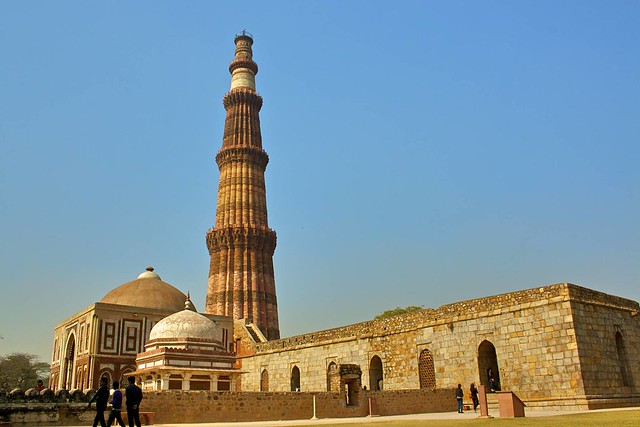 |
| Qutub Minar Complex/Source: Sakeeb |
| Dynasty/Ruler | Time Period |
|---|---|
| Tomar | Early twelfth century-1165 |
| Ananga Pala | 1130-1145 |
| Chauhans | 1165-1192 |
| Prithviraj Chauhan | 1175-1192 |
| Slave Dynasty | 1206-1290 |
| Qutbuddin Aybak | 1206-1210 |
| Shamsuddin Iltutmish | 1210-1236 |
| Raziyya Sultan | 1236-1240 |
| Ghiyasuddin Balban | 1266-1287 |
| Khalji Dynasty | 1290-1320 |
| Jalaluddin Khalji | 1290-1296 |
| Alauddin Khalji | 1296-1316 |
| Tughluq Dynasty | 1320-1414 |
| Ghiyasuddin Tughluq | 1320-1324 |
| Muhammad Tughluq | 1324-1351 |
| Firuz Shah Tughluq | 1351-1388 |
| Sayyid Dynasty | 1414-1451 |
| Khizr Khan | 1414-1421 |
| Lodi Dynasty | 1451-1526 |
| Bahlul Lodi | 1451-1489 |
Finding Out about the Delhi Sultans
- Inscriptions, coins and architecture are the major sources of information on the Delhi Sultans.
- Tawarikh are especially valuable. They are histories written by learned men such as secretaries, administrators, poets and courtiers who both recounted events and advised rulers on important issues. Tawarikh were written in Persian.
- However, the authors of twarikhs lived only in cities, hopeful of getting high rewards and advised rulers on the need to preserve the social order which was discriminatory in nature.
Raziyya Sultan
- In 1236, Raziyya Sultan became first and last female ruler of Delhi.
- She was described as more able and qualified thanall her brothers by chronicler of that time, Minhaj-i-Siraj.
- As many were not comfortable with the idea of a Queen as ruler. She was removed from the throne in 1240.
- Her rule was even more impressive as she has described herself as the daughter of Iltumish whereas Rudramadevi (1262-1289) hide her identity under a male name.
Another Queen named Didda, ruled in Kashmir (980-1003). Her title is interesting as it traces to "didi" or "elder sister", an obviously affectionate term given to a loved ruler byher subjects.
The expansion of the Delhi Sultanate
- In th early 13th century, control of Delhi Sultans rarely went beyond foritified towns. It was challange from Mongol and rebelling Governors which made Delhi Sultans think about their strategy.
- The exapain occur during the reign of Ghiyasuddin Balban, Alauddin Khalji and Muhammad Tughluq.
- During first set of campaigns, control over internal fronters, hinterlands was ensured.
- The second exapansion happened along external frontier. They campaigned into South India and captured elephants, horses, slaves and carried away precious metals.
The Masjid
- A mosque is called a masjid in Arabic, a place where Muslims prostrate in reverence to God (Allah).
- An Imam is most respected learned man who lead rituals and friday prayers.
- During prayers, muslims stand facing Mecca. In India, this is to west. This is known as qilba.
- Delhi Sultans built several mosque throughout the subcontinent. Quwwat-al-islam (Qutub Minar Complex) was the first such mosque ever built.
Administration and Consolidation under the Khaljis and Tughluqs
- Early Delhi Sultans (Slave Dynasty) relied on their slaves puchased for military service, called bandagan in Persian, for the administration of different sections of sultanates, instead of giving the posts to aristocrats and landed chieftans.
- Later, both Khaljis and Tughluqs also used bandagan as governors and raised people of humble birth to important political positions.
- The territories under these bandagan governors were known as iqta and these governors were known as iqtadar or muqti.
- The duty of muqti is maintain law and order in their iqtas. In exchange of their services, they collected the revenue as their salaries. They also paid to their soldiers from these revenue and run other affairs.
- The iqtadari was not inheritable and muqtis can be transferred on the whims and fancies of the Sultans. In addition, accountants were appointed to check the amount of revenue collected.
- As Delhi Sultante expanded, the local chieftans were made devoid of their land revenue collection rights and forced to pay the taxes.
- There were three types of taxes – (1) on cultivation known as kharaj, amounting to about 50 per cent of the produce, (2) on cattle and (3) on houses.
- However, it was extemely difficult to control distant provinces and several regions such as Bengal and Southern India declared their independence from the Sultanate in a short period of annexation.
- Mongols were a problem to Delhi Sultans as early as 1219 when they attacked north-east Iran. The attacks were later increased during the times of Alauddin Khilji and Muhammad Tughluq.
The Sultanate in the Fifteenth and Sixteenth Centuries
- After the Tughluqs, Sayyid and Lodi dynasties ruled from Delhi and Agra until 1526.
- By then, Jaunpur, Bengal, Malwa, Gujarat, Rajasthan and the entire South India had independent rulers with flourishing states and prosperous capital cities.
- At the same time, Rajput and Afghan rulers came into the play. Some small but strong states also rose to prominence. Sher Shah Suri (1540-1545) who started as the manager of a small territory for his uncle in Bihar and eventually challenged and defeated the Mughal emperor Humayun (1530-1540, 1555-1556) and captured Delhi and established his own dynasty.
